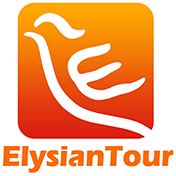Hanyang Mausoleum
- Total Area: 20 square km
- Length: 6 km
- Width: 3.3 km
- Construction Time: 153 BC
Situated about 20 kilometers (12 miles) north of Xian City, Hanyang Mausoleum is a large joint tomb complex of the Jingdi Emperor Liu Qi and his empress Wang in Western Han Dynasty (206 BC-24AD). First built in 153 BC, the mausoleum occupies a striking area of 20 square kilometers. A magnificent underground museum was built on the original site of the tomb ruins to display the burial objects and cultural relics unearthed, with glass-bottomed walkway for clear and straight views. Countless pottery figures and sculptures are neatly arrayed in the pits to restore the prosperous civilization during the reign of Jingdi Emperor.
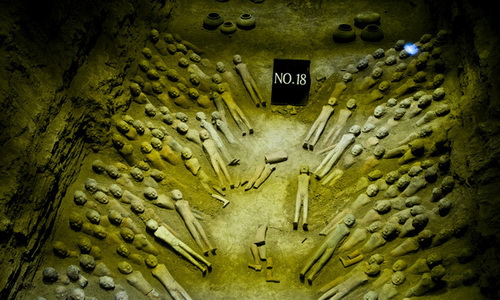
As the fourth emperor of the Western Han Dynasty, the emperor Jingdi Liu Qi had been on the throne for 17 years long. During his reign, he pioneered another flourishing golden area after Han Dynasty based on his father Wendi Emperor's achievements. The country was in the heyday of peace and wealth, and the life standards of common citizens were also greatly improved, which made Han become one of the most prosperous eras in history. Therefore, his father and his presidential periods were praised as the Prosperity of Wen-Jing Era (Wenjing Zhizhi).
Centered on the emperor's tomb, the entire mausoleum was designed with neatly symmetrical layout, revealing the sovereign status of the emperor and rigid hierarchy system of Chinese feudal court. Hanyang Mausoleum is mainly made up of the emperor's tomb, the empress' tomb, southern and northern subordinate pits, ceremonious structures, human sacrifice graveyard and criminals' cemetery. Facing to the east, the Emperor's Tomb is surrounded by 81 radial burial pits, including more than 1,000 accompanied tombs of the royal families, civil and military officials, and about 200 burial pits holding a great number of cultural relics in store.
However, the core tomb of Jingdi Emperor has not been unearthed yet, and only a small part of the subordinate tombs were excavated to display the burial objects. The areas available for sightseeing now include the Underground Museum, Ruins of Nanque Gate and the Exhibition Hall of Archeological Excavations.
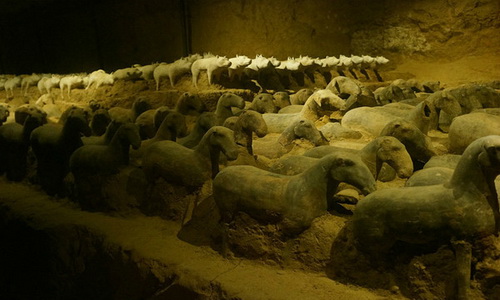
Built on the original site of the pits without moving any burial objects, the underground exhibition hall is facilitated with all glass walls and corridors to display pottery figures beneath visitor's feet. Under the glass-bottomed walkway rest a great number of lifelike pottery soldiers, dancers, ladies and livestock figurines, which are the biggest highlights of Hanyang Tomb.
- Miniature Clay Figures
- Armless Naked Pottery Figures
- Women Pottery Figures
- Kneeling Pottery Figures
- Animal Figures
Compared with the life-sized Terracotta Warriors of Qin Dynasty, those figures unearthed from Hanyang Mausoleum are as small as only one-third the size of real people, but they are more diverse and exquisite. Different from the mighty military power that Emperor Qinshihuang tried to show, Hanyang Mausoleum showcases more about the thriving life scene of emperors by creating a rich miniature world with armed soldiers, maids, women dancers and livestock.
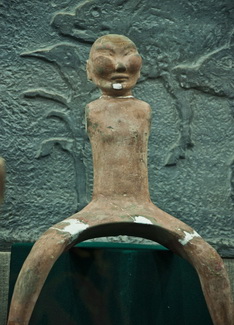
Excavated from the supreme mausoleum of Western Han Dynasty, a large number of pottery figures wearing mysterious smiles were surprisingly found naked and armless. Actually, these figures used to have wooden removable arms that had decayed after 2,000 years'erosion, which could be proved from the two holes on their shoulders and the wood dust found in the pits. Meanwhile, these pottery figures were nor buried naked either, but dressed in fancy silk costumes of Han Dynasty, which were also gone with the corrosion likewise.
The maids are the most exquisite ones among all the pottery figures. Graceful and trendy, these maids wear traditional long robes with three-layered collars, revealing the most authentic dress culture of ancient Han women. Besides, you would be surprised at the exaggerative women cavalries, which are definitely seldom seen in any other Chinese imperial mausoleum. The women cavalries, in fact, were from nomadic groups who married Han people for peace between countries, but they still maintained their traditions to living a life on horseback.
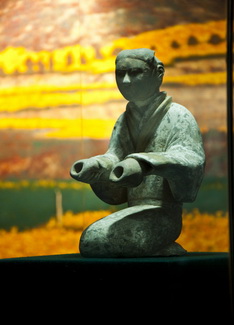
In the mausoleum, there are an array of kneeling figures, and some visitors speculated they had lower social status. However, sitting on heels had been a living tradition for thousands of years in ancient China, and particularly in Han Dynasty kneel sitting was applied to most formal occasions among both imperial families and common people. It was an etiquette of politeness and graceful-looking.
Different from any other mausoleum, Hanyang Tomb houses a mass of livestock figurines, including the oxen, horses, pigs, dogs and chickens. They were buried to ensure the enough food supply of the court banquets for Jingdi emperor and other imperial families in afterlife. Shaped by sophisticated craftsmanship, the livestock figures look so vivid that even you could distinguish the house dogs from wild dogs by their upturned and lop tails.
The museum also exhibits abundant cultural relics of living articles unearthed from the burial pits and accompanied tombs. Those archeological excavations, including spears, swords, arrows, coins, pottery jars and bronze mirrors, demonstrate a more vivid and prosperous scene of the imperial lifestyle.
Que, referring to tall gate tower in Chinese, is a symbolic ritual structure on both sides of the entrance to imperial palaces and mausoleums. There used to be four Que gates on each side of the rectangular Hanyang Tomb complex, but northern and eastern gates had been destroyed while the ruins of west gate has not been unearthed yet.
After a series of excavation, Nanque, the south gate of the Hanyang mausoleum was proved to be a cluster of triple-Que gates, which was the supreme ritual structure of imperial mausoleum in ancient China. On the site of the gate lies a museum for visitors to spot the column base, stairways and tiles that date back about 2,000 years ago. The conservation hall itself is blessed with pseudo-classic architectural style of Han Dynasty, designed with three gate towers that are exclusive to imperial tombs.
1. You are required to wear shoe covers to walk on the glass walkway so as not to damage the floor and to keep it clean.
2. Hiring a guide is highly recommended if you want to discover Hanyang Mausoleum in a more interesting way.
3. It is quite convenient to have a trip to the Hanyang Tomb as it is nestled on the way to the airport. You could drop by the site during the transfer between the airport and the downtown Xian.
CNY 90 (Mar. - Nov.)
CNY 65 (Dec. - Feb.)
Opening Hours:(Mar. - Nov.): 8:30 - 17:00
(Dec. - Feb.): 8:30 - 18:00
Interpretation Service:Underground Museum: CNY120
Exhibition Hall of Archeological Excavations: CNY200
Transportation Guide:- From Xian: At the Exit D of Xian City Library (Shi Tu Shu Guan) Subway Station, you could take the Tourist bus line 4 to Hanyang Tomb directly.
- From Xianyang: Take the bus No. 4 from Xianyang Railway Station to Hanyang Mausoleum.
- Car Rental from Xian Downtown: It takes about 40 - 60 minutes and costs about CNY200 from Xian downtown to Hanyang Tomb.

